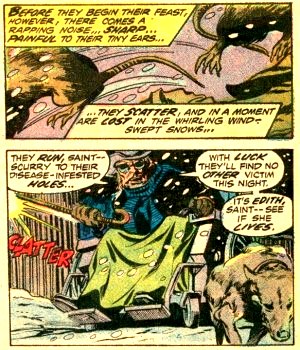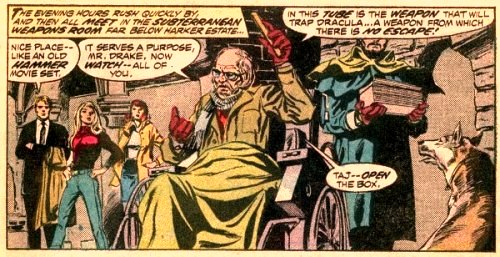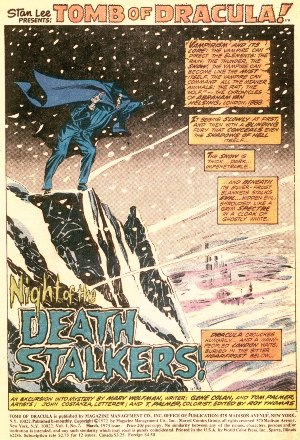| |
| It becomes
evident that he is the driving force behind our group of
vampire hunters, carrying on a lifelong crusade to fight
and destroy vampires, and in spite of being old and
paralyzed, Quincy Harker is the mastermind behind the
group effort, very much along the lines of what
"Q" is to James Bond, although later issues
will reveal that he is also quite capable of battling
Dracula face to face. |
| |
| The plot of
Wolfman's first issue introduces two themes which
would reoccur on several occasions throughout the
series: Dracula's ability to control human
individuals (in this case, a group of children is
turned into a band of Zombie-like attackers under
the hypnotic spell of Dracula), and a staged
encounter in a deserted place between the vampire
count and the vampire hunters (in this case,
Dracula lures Harker's group to a deserted
house); more often than not, the place has been
set up with all sorts of booby-traps in order to
bring the opposing side down. By confronting the vampire
hunters with the dilemma of having to fight
innocent children in order to avert Dracula's
attack without harming them - after all, they are
innocent and are only being manipulated - Wolfman introduces a thread of
moral philosophy to the storytelling, something
which he would expand and elaborate in future
issues even to include the vampire count himself.
Wolfman's first
assignment with Tomb of Dracula also contains the
first small digression from the continuity of the
established timeline of the plot as set up in
previous issues. Few readers may have noticed at
the time that the fact that Dracula ironically
calls Harker an "old friend" the first
time they meet is inconsistent with what has been
relayed so far.
|
|

Quincy Harker makes his first appearance on page
4 of Tomb of Dracula #7
|
|
| |
| If Dracula had been
"dead" since Abraham van Helsing and Jonathan
Harker put an end to his reign of terror (as readers were
told since Tomb of Dracula #1), then Dracula should not
have met Harker's son at all, let alone often enough to
call him an "old friend". |
| |

Frank Drake is introduced to Quincy Harker's
methodology - and indeed technology - of vampire
hunting on page 7 of Tomb of Dracula #7;
note the reference to a "Hammer movie
set"
|
|
"Seven
years ago we all went through the flames. And the
happiness of some of us since then is, we think,
well worth the pain we endured. It is an added
joy to Mina and to me that our boy's birthday is
the same day as that on which Quincey Morris
died. His mother holds, I know, the secret belief
that some of our brave friend's spirit has passed
into him. His bundle of names links all our
little band of men together. But we call him
Quincey. (...) We were talking of the
old time (...) Van Helsing summed it all up as he
said, with our boy on his knee. 'We want no
proofs. We ask none to believe us! This boy will
some day know.'"
[Bram Stoker, Dracula, chapter 27
(Jonathan Harker's Diary), final page]
|
|
| |
| This small detail is, however,
significant for future issues in two respects. Firstly,
Wolfman anticipates what he has planned for the series,
namely to make Quincy Harker the major opponent of
Dracula and hence portray the two as "old
rivals" as the story moves on, and secondly, Wolfman
is shaping out his own interpretation of the storyline
from Tomb of Dracula #1-6. |
| |
The visual
department had been in the best possible hands
since the first issue, but the frequent change of
writers posed a problem - as Marv Wolfman
concluded immediately when he was handed Tomb
of Dracula #7 as author number four.
"I realised
pretty quickly that in order to do anything I
had to decide on the handling of the
characters and what the series was about
(...) One of the things I did was write up
pages upon pages of notes on who the
characters were and where I wanted them to
go. I was less concerned about the individual
plots at this point than I was about the
direction of the characters. So I would write
almost up to two years ahead, all the
different turns of the characters and where
they were gonna be, and issue by issue what
would happen with the character. Then I went
back and worried about the stories to make it
work." (Comic Geek
Speak, 2005)
Marv
Wolfman's approach worked out just fine, and as
with artist Gene Colan his name would soon become
inseparable from the series as he was set to stay
on the book until its demise in August 1979.
|
|

|
|
| |
Wolfman's source of inspiration
came entirely from Stoker's novel and completely
by-passed the movies (even though he actually made a
dialogue reference to the Hammer productions in his very
first script) - perhaps surprisingly at first sight in
view of the strength and presence of the popular culture
image of Dracula, but quite logical at second thought for
a wordsmith rather than a visual artist.
"I
was not a big fan of that sort of stuff, and in terms
of movies I'd never seen a Dracula movie at that
point, but I'd read the novel, and I loved the novel,
and that was my only influence." (Siuntres, 2006)
|
| |